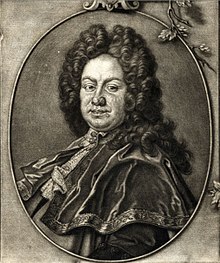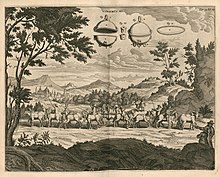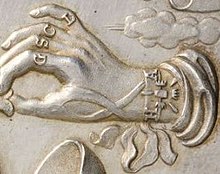Air pump thaler

Luftpumpentaler , Zwietrachttaler and Separation Taler are the names of the commemorative taler from 1702, which was coined in two variants and depicts the attempt to separate the Guerickean hemispheres through horse power. The reason for the coinage was the separation of fraternal unity between the two Brunswick dukes Rudolf August and Anton Ulrich (1685–1704) of the Principality of Brunswick-Wolfenbüttel .
There is also a very rare medal with the coin image of the air pump thaler and a gold strike of 10 ducats .
Coin description
The in two variants in the mint Goslar or Zellerfeld without Münzmeisterzeichen coined in 1702 very rare commemorative coins are Reichstaler (silver, weight 29 grams) of the Principality of Brunswick-Wolfenbüttel. They show the physical experiment of the Magdeburg physicist, councilor and mayor Otto von Guericke (* 1602, † 1686) to demonstrate the effect of air pressure : After two metal hemispherical shells were placed together airtight and a strong reduced pressure was generated with the help of an air pump , the Magdeburg hemispheres were able to penetrate Horse power cannot be torn apart.
front
- Two horses in a landscape try in vain to pull apart the hemispheres, which are closed under pressure and labeled RAV, in the background there is a unicorn, above it an eagle hurling lightning bolts. QVOD VI NON POTVIT is embossed in a curved shape above the coin.
- The other variant of the thaler (the lower coin) does not have an eagle in the coin image. A banner with NON-VI can be seen in the clouds.
back
- The open spherical shells lie on a table in a landscape. A hand that has opened the valve is located on the valve of a hemispherical shell. The five letters PGSCL are embossed on the five fingers, beginning with the thumb. A tape with the inscription DISIECTVM EST ARTE MINISTRA flutters above the clouds. At the bottom of the section is the Roman year MDCCII.
- The banner of the other variant bears the words SED ARTE. In contrast to the first version, a bracelet with the Holstein nettle leaf between the letters H - A can be seen on the hand . The letter P on the thumb is missing.
Coin inscription and individual letters
- The Latin writing on the front and back, QVOD VI NON POTVIT // DISIECTVM EST ARTE MINISTRA, translated from Johann David Köhler (1744) reads : “What could not be done by violence // Has been thrown apart by the aid of art . "(What could not be achieved by violence, was separated with the help of art.)
- The Latin writing on the front and back of the other variant in the overall picture below NON VI // SED ARTE translates as: "Not through violence // but through art."
- The individual letters on the back have the following meanings:
- RAV (on the hollow ball) represents the concord R udolf A ugusts and A nton U lrichs.
- The five letters PGSCL on the five fingers of the hand are the abbreviations for names, of which the P on the thumb in connection with H - A and the nettle leaf on the wrist on the back of the other variant by Koehler was found. Accordingly, it is Duke H ans A dolf von P lön .
Coin history
The so-called Luftpumpentaler was coined “on the separation of fraternal harmony” between the two dukes of Braunschweig. Which person is meant on the taler who contributed significantly to the discord is interpreted differently. The wife of Anton Ulrichs, née Princess von Holstein, is said to have caused the separation through her intrigues (according to von Schrötter; H. Halke; transpress lexicon, etc.). The hand with the Holstein nettle leaf, interpreted as a woman's hand, which opens the valve on the back of the taler, is a symbol of this. At least that is the most common interpretation. According to Schmieder, the lock of the bracelet on the hand, on the back of the thaler, has "the shape of the Holstein nettle". Therefore, according to Schmieder, "one interprets this idea on the wife of Anton Ulrich, Elisabeth Juliane, a princess of Holstein, but the whole medal on a fraternal quarrel between the dukes that was delicately initiated by her."

According to Johann David Köhler's "Münzbelustigung", the nettle leaf and the letters H - A on the wrist of the hand that opened the valve are not for Anton Ulrich's wife, but for Duke Hans Adolf von Plön (* April 8, 1634, † April 8, 1704). This is the son-in-law of Duke Rudolph August von Braunschweig-Wolfenbüttel. The woman's hand on the back of the taler, which symbolizes the separation of unity, therefore belongs to a man. The first thaler variant with the eagle bears the letter P (for Plön) on the thumb of the hand on the back. In the other variant, the P is missing, but the letters HA (for Hans Adolf) are on the wrist. This was thought up in connection with the Holstein nettle leaf “for a clear and reliable interpretation”, so Köhler's convincing argument.
The Luftpumpentaler from 1702 are the first to depict the attempt to separate the Guericke hemispheres and the first ever to refer to Otto von Guericke. Although the inventor was internationally famous, there was no coin or medal dedicated to him or his invention during his lifetime.
The attempt to prove the air pressure effect was interpreted politically by the Principality of Braunschweig-Wolfenbüttel in the coin image of the Luftpumpentaler.
Köhler's historical declaration (1744)
Johann David Köhler (* 1684, † 1755) described the two variants of the so-called Luftpumpentaler as "two ingenious Schaumüntzen of Duke Anton Ulrichs zu Braunschweig-Wolfenbüttel on the caused separation of the brotherly unity of A. 1702". In his historical declaration, the scholar published the contents of a letter with an attachment from the author, whose father had been "in the good service" of Duke Anton Ulrich. Köhler wrote comments on this letter with attachment.

“The main work”, according to the author of this letter, “presents a hollow sphere composed of two pieces. [...] von Guerike has made a new wonder of the world out of this. Because when he pulled out the thick air with the help of his air pump , it was found how the outer surrounding air held the two spherical pieces together so firmly and inseparably that the force of horse and mouth could not tear them apart. The names of the Princely Brothers Rudolf August and Anton Ulrich held together in the monogram RAV. […] When the then High Princely House of Hanover received a churation A. 1692: Both […] brothers judged that this should cause a mess in their house, since the seniorate [= order of succession, law of elders ] was introduced […]. And because the Duchy of Cell [...] was to be combined with Hanover to reinforce the electoral dignity, both gentlemen brothers thought this was even more disadvantageous [...]. […] They [turned to the King of France on] matters of their house . When France took control of it after the opening of the Spanish monarchy [...], the whole of Europe was brought into armor to oppose this project with all its might . And under these circumstances [...] the Braunschweig-Wolfenbüttel alliance could not be viewed as anything other than an epidemic in the German Empire . [...] Only when the electoral and the celibate invaded the country [1702] did the Brunswick ministers find a means to separate this so united brother band [...], [...]. "
Köhler adds to the explanation of the obverse of the thaler in his comment that "the horse on the right side represents the Hauß cell and the horse on the left side represents the Churhauß Hannover ". The coat of arms on the horse pulling to the right is empty "because of the ore office, which was still disputed at the time [...]." The unicorn , according to Koehler, is " to lick the Great Britain coat of arms shield holder [...] that looks around at the falling thunder rays of the eagle . [...] The eagle with the thunder rays shooting down is aimed at the very serious commands [of the emperor] to Duke Rudolph Augusten. [...] On February 8th [= issuing of the mandate] Hertzog Anton Ulrichen was ordered [...] to completely dismiss the state government. "Out of concern, the scholar said," the first symbol was the eagle falling down with thunder and lightning " Is badly received at the imperial court ," another medal was struck, whereupon the eagle with the thunderbolts was left out. "
"On the other [thaler is on the hand] a bracelet with the Holstein Nesselblat [...]." From the letters of the hand, "want to make some whole words [...]. - such riddles may be solved by others. ”Says the author of the letter.
"HA" [on the strap on the wrist], so Köhler's explanation, "that is Hans Adolf , and the Holsteinsche Nesselblat [serves] for a clear and reliable interpretation [of the letters]". Hans Adolf is Duke Hans Adolf von Plön, the “son-in-law of Rudolph Augusts. [...] Because the Kayser used the same as such a close relative [...] to turn Duke Rudolph August away from his brother [...] and instructed him [...] to insinuate [= carry out] the sharp mandates [...] [...]. ”He and other people, whose name letters are on the fingers of the hand, are said to have tried to disturb the harmony of the ducal brothers. Köhler also names the names that match the other letters but come from other sources and adds: "What truth I didn't want to face."
annotation
Rudolf August's brother Anton Ulrich became the emperor's opponent because the younger line of Hanover received the electoral dignity in 1692 despite being a senior citizen . The seniorate was introduced by the dukes Bernhard and Heinrich in 1414. In 1555 it was confirmed by Emperor Charles V and then by his successor . Emperor Leopold I nevertheless elevated Braunschweig-Lüneburg to the electorate of Hanover . Anton Ulrich was excluded from co-regency by an imperial mandate on February 8, 1702 as a punishment for his alliance with France. He complied pro forma, but continued to rule with his brother until he became sole ruler through his death on January 26, 1704.
See also
- Schmalkaldic federal thaler from the federal mint in Goslar
- Farmers' groschen from the Goslar mint
- Lichttaler from the Goslar Mint
- Truth thaler from the Goslar mint
- Mosquito thalers from the mint in Osterode am Harz and Goslar
literature
- Friedrich von Schrötter, N. Bauer, K. Regling, A. Suhle, R. Vasmer , J. Wilcke: Dictionary of Coin Studies , Berlin 1970 (reprint of the original edition from 1930)
- Heinz Fengler, Gerd Gierow, Willy Unger: transpress Lexikon Numismatics , Berlin 1976
- Gerhard Schön: German coin catalog 18th century , Munich: Battenberg, 1984
- Heinrich Halke: Concise dictionary of coinage and its auxiliary sciences , Berlin 1909
- Carl Christoph Schmieder: Addendum to the concise dictionary of all coinage ... , Halle and Berlin 1815
- Johann David Köhler: Historischer Münz-Amustigung Volume 16 published weekly in 1729 , 1744
- Werner Conze, Volker Hentschel: German history, epochs and dates , Freiburg / Würzburg 1996, ISBN 3-87640-380-4 .
Web links
Individual evidence
- ↑ Heinz Fengler, ...: transpress Lexikon Numismatics ..., p. 207
- ^ Gerhard Schön: German coin catalog 18th century ..., p. 158: Gold strike of 10 ducats
- ↑ Friedrich von Schrötter…: Dictionary of Coin Studies …, p. 362
- ^ Heinrich Halke: Concise dictionary of coinage ..., p. 190
- ↑ Johann David Köhler: Historischer Münz-Amustigung Volume 16, 41. 42nd piece, p. 322
- ^ Johann David Koehler: Historischer Münz-Amustigung Volume 16, 41. 42nd piece, p. 325
- ^ Johann David Köhler: Historischer Münz-Amustigung Volume 16, 41st 42nd piece, pp. 332/333
- ^ Johann David Köhler: Historical Coin Amusement Volume 16, 41st 42nd piece, p. 332 (27)
- ^ Gerhard Schön: German coin catalog 18th century ..., p. 158 (20; 21)
- ^ Carl Christoph Schmieder: Addendum to the concise dictionary of the entire coinage ... p. 121
- ↑ Johann David Köhler: Historischer Münz-Amustigung Volume 16, 41. 42nd piece, p. 333
- ↑ Münsteransche Numismatic Newspaper No. 2, August 2007: Klaus Werner, Magdeburg…: medals,… on Otto von Guericke, p. 1
- ^ Johann David Koehler: Historischer Münz-Amustigung Volume 16, 41. 42nd piece, p. 321
- ↑ Johann David Köhler: Historischer Münz-Amustigung Volume 16, 41st 42nd piece, pp. 321–336
- ^ Johann David Köhler: Historischer Münz-Amustigung Volume 16, 41. 42nd piece, p. 326


